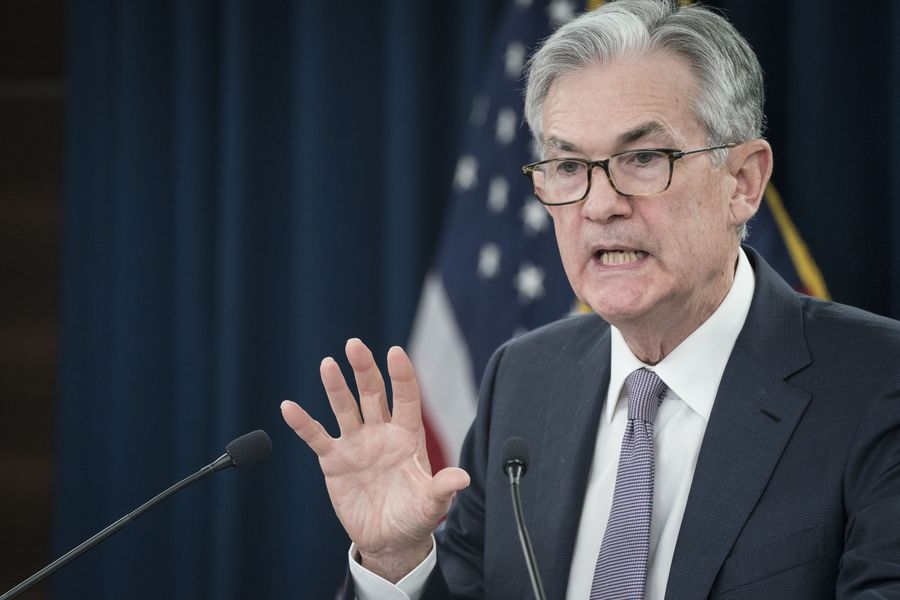
Traders work at the New York Stock Exchange in New York, the United States, on Oct. 30, 2019. (Xinhua/Wang Ying)
The Federal Reserve's policy adjustments and a positive outlook on U.S.-China trade relations are the two key factors that influenced the market, analysts say.
NEW YORK, Dec. 31 (Xinhua) -- U.S. equities had a stellar 2019, with all three major indexes up more than 20 percent, despite a year of volatility and uncertainties.
With one trading day left in 2019, the Dow Jones index has climbed up about 22 percent so far this year, and the broader S&P 500 and the tech-heavy Nasdaq have risen 28 percent and 35 percent respectively.
The Federal Reserve's policy adjustments, as well as a positive outlook on U.S.-China trade relations are the two key factors that influenced the market, analysts have said.
FED POLICY A BIG BOOST
Economic research consultancy Capital Economics said in its "Key market calls for 2020" that a large chunk of the rise in equity markets this year appears to have come thanks to the substantial loosening of monetary policy, which has spurred an increase in valuations.
Many strategists and traders shared this view.
The biggest market mover this year really is the Fed changing its policy, Matthew Cheslock, an equity trader with Virtu Financial, told Xinhua.
Major indexes tumbled at the end of last year and the beginning of this year when the market feared a recession was on the horizon.
The fear of a U.S. economic recession came with trade tensions and uncertainties between the United States and its major trading partners, as well as a global economic slowdown, experts have noted.
In March and August, the market saw two steep sell-offs caused by an inverted yield curve, which is generally considered a reliable indicator for a looming recession.
Yet, market sentiment was boosted each time the Fed made policy adjustments.
On Jan. 4, Federal Reserve chair Jerome Powell said the central bank will be patient about rate hikes on Jan 4. The Dow and S&P 500 both rose 3.35 percent, while the Nasdaq surged 4.16 percent.

U.S. Federal Reserve Chairman Jerome Powell speaks during a press conference in Washington D.C., the United States, on Dec. 11, 2019. (Photo by Sarah Silbiger/Xinhua)
All three major indexes notched a more than 2 percent gain on June 4 after Powell said the Fed was watching current economic developments and would do what it must to keep the near-record expansion going.
In July, the central bank lowered interest rates for the first time in more than a decade, and subsequently cut rates in September and October.
Barry Bannister, head of institutional equity strategy at Stifel, said the Fed caused most of the U.S. economic and market turbulence since 2018, but that the central bank has later retreated.
He said following the Fed is "the key to get ahead in equity investment." The Fed, currency rates and yields are crucial elements driving the market.
MARKET EMBRACES BETTER TRADE PROSPECTS
On Dec. 13, the Chinese side announced that Beijing and Washington have agreed on the text of a phase-one economic and trade agreement based on the principles of equality and mutual respect.
The news swiftly lifted investors' sentiment and started the stock market's year-end rally. All three major indexes hit record highs with the Nasdaq breaking above the 9,000 psychological mark for the first time last week.

Visitors look at toy products at the booth of Hape Toys during the 116th Annual North American International Toy Fair at the Jacob K. Javits Convention Center in New York, the United States, on Feb. 18, 2019. (Xinhua/Wang Ying)
Market participants treated the phase-one deal as a signal that the two sides will de-escalate bilateral trade tensions.
"We think it is significant that the announcement represents the first time that trade negotiations have led to an actual reduction in tariffs, rather than a mere delay," said Mark Haefele, global chief investment officer at UBS Wealth Management.
He added that the two countries may have reached the point of "peak tariffs" and the deal could be the start of a series of phased roll-backs.
"This could unlock further upside for equity markets, driven by an improvement in business confidence and a recovery in investment," said Haefele and his research team in a note.
He said attractive valuations for stocks relative to high grade bonds should lead to outperformance over a six- to 12-month investment horizon.
CAUTIOUSLY OPTIMISTIC ABOUT 2020
Investors and analysts have been cautiously optimistic about the performance of the U.S. equities market in 2020, as challenges still remain.
Bank of America Global Research estimated that the S&P 500 would reach 3,300 by the end of 2020. The S&P 500 earnings per share is forecast to grow 8 percent to 177 U.S. dollars at year-end.
Bannister said the potential risks for 2020 include a recession, Fed missteps, and geopolitical issues.
The U.S. gross domestic product is estimated to pull back to trend, with growth averaging 1.7 percent over the next two years, according to the Bank of America Global Research in its year-ahead outlook.
Other analysts also cautioned that political uncertainties may impact the equity market next year.
Capital Economics said that the presidential election is shaping up to be a key inflection point for U.S. equities, given the major policy differences between different candidates. Some policies advocated by progressive Democrats could have a major negative impact on U.S. equities. ■



